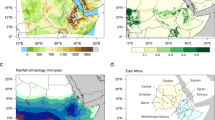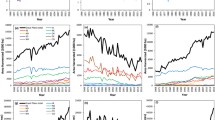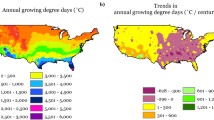Abstract
Ethiopia experiences significant climate-induced drought and stress on crop and livestock productivity, contributing to widespread food insecurity. Here, we present subseasonal crop water stress analyses that indicate degrading, growing conditions along Ethiopia’s eastern highlands, including productive and populated highland regions. These seasonally shifting areas of increasing water stress stretch from the north to south across eastern Ethiopia, intersecting regions of acute food insecurity and/or high population. Crop model simulations indicate that between 1982 and 2014, parts of eastern Amhara and eastern Oromia experienced increasing water deficits during the critical sowing, flowering, and ripening periods of crop growth. These trends occurred while population in these regions increased by 143% between 2000 and 2015. These areas of enhanced crop water stress in south-central Ethiopia coincide with regions of high population growth and ongoing crop extensification. Conversely, large regions of relatively unpopulated western Ethiopia are becoming wetter. These areas may therefore be good targets for agricultural development.





Similar content being viewed by others
References
Allen RG, Jensen ME, Wright JL, Burman RD (1989) Operational estimates of reference evapotranspiration. Agron J 81:650–662
Chamberlin J, Schmidt E (2011) Ethiopian agriculture: a dynamic geographic perspective. IFPRI, Washington DC
CIESIN (2005) CIAT (Center for International Earth Science Information Network–CIESIN-Columbia University, United Nations Food and Agriculture Programme-FAO, and Centro Internacional de Agricultura Tropical-CIAT): Gridded Population of the World, Version 3 (GPWv3): Po.
CSA (2015) Ethiopian Agriculture and Natural Resource Statistics. Ethiopian Central Statistical Agency
CSA (2007) Population and housing census report—country—Ethiopia Central Statistics Agency.
Doorenbos J, Pruitt WO (1977) Crop water requirements. Food and Agriculture Organization, Rome, Italy
FAIS (2016) World food aid flows. UN World Food Program
Ferede T, Ayenew AB, Hanjra MA, Hanjra M (2013) Agroecology matters: impacts of climate change on agriculture and its implications for food security in Ethiopia. Glob food Secur Emerg issues Econ Implic:71–112
FEWS NET (2015) Illustrating the extent and severity of the 2015 Ethiopia drought. Ethiopia Special Report, Washington
Frere M, Popov GF (1979) Agrometeorological crop monitoring and forecasting. Food and Agriculture Organization, Rome
Frere M, Popov GF (1986) Early agrometeorological crop yield forecasting. Food and Agriculture Organization, Rome, Italy
Funk C, Brown ME (2009) Declining global per capital agricultural capacity and warming oceans threaten food security. Food Secur J 1:271–289
Funk C, Harrison L, Shukla S, et al (2016) Assessing the contributions of local and east Pacific warming to the 2015 droughts in Ethiopia and Southern Africa.
Funk C, Husak G, Michaelsen J et al (2013a) Attribution of 2012 and 2003-12 rainfall deficits in eastern Kenya and southern Somalia. Bull Am Meteorol Soc 94:S45–S48
Funk C, Mahiny AS, Husak G et al (2013b) Blending local scale information for developing agricultural resilience in Ethiopia. Ref Modul Earth Syst Environ Sci 2:165–175. doi:10.1016/B978-0-12-384703-4.00234-3
Funk C, Peterson P, Landsfeld M et al (2015a) The climate hazards infrared precipitation with stations—a new environmental record for monitoring extremes. Sci Data 2:150066. doi:10.1038/sdata.2015.66
Funk C, Rowland J, Eilerts G et al (2012) A climate trend analysis of Ethiopia. US Geological Survey, Boulder
Funk C, Salmanmahiny A, Husak G (2014a) Large scale environmental assessment and degradation management: the case of food insecurity in Ethiopia. Environ Resour Res 2:147–166
Funk C, Senay G, Asfaw A et al (2005) Recent drought tendencies in Ethiopia and equatorial-subtropical Eastern Africa. Famine Early Warning System Network. USAID, Washington DC
Funk C, Verdin A, Michaelsen J et al (2015b) A global satellite assisted precipitation climatology. Earth Syst Sci Data 8:401–425. doi:10.5194/essdd-8-401-2015
Funk CC, Dettinger MD, Michaelsen JC et al (2008) The warm ocean dry Africa dipole threatens food insecure Africa, but could be mitigated by agricultural development. Proc Natl Acad Sci 105:11081–11086. doi:10.1073/pnas.0708196105
Funk CC, Peterson PJ, Landsfeld MF et al (2014b) A quasi-global precipitation time series for drought monitoring. US Geological Survey, Reston
Glewwe P (1990) The measurement of income inequality under inflation. J Dev Econ 32:43–67
GOE (2015) Joint government and humanitarian partners’ document. Government of Ethiopia and partners. Addis Ababa, Ethiopia
Headey D, Taffesse AS, You L (2014) Diversification and development in pastoralist Ethiopia. World Dev 56:200–213
Hurni H (1998) Agroecological belts of Ethiopia. Explanatory notes on three maps at a scale of 1:1,000,000. Soil conservation research programme.
Husak GJ, Marshall MT, Michaelsen J et al (2008) Crop area estimation using high and medium resolution satellite imagery in areas with complex topography. J Geophys Res 113:D14112. doi:10.1029/2007JD009175
IPC (2012) Integrated food security phase classification technical manual version 2.0: evidence and standards for better food security decisions. Food and Agriculture Organization (FAO), Rome
Jury MR, Funk C (2013) Climatic trends over Ethiopia: regional signals and drivers. Int J Climatol 33:1924–1935
Korecha D, Barnston AG (2007) Predictability of June-September rainfall in Ethiopia. Mon Weather Rev 135:628–650
Little PD, Behnke R, McPeak J, Gebru G (2010) Pastoral economic growth and development policy assessment, Ethiopia. Department for International Development (DfID), London, UK
Lyon B, DeWitt DG (2012) A recent and abrupt decline in the East African long rains.
Mekasha A, Gerard B, Tesfaye K et al (2014) Inter-connection between land use/land cover change and herders’/farmers’ livestock feed resource management strategies: a case study from three Ethiopian eco-environments. Agric Ecosyst Environ 188:150–162
Nassef M, Belayhun M (2012) Water development in Ethiopia’s pastoral areas: a synthesis of existing knowledge and experience. Washingtion DC
NMA (2014) Annual climate bulletin for the year 2013. Ethiopian National Meteorological Agency.
Pricope NG, Husak G, Lopez-Carr D et al (2013) The climate-population nexus in the East African Horn: emerging degradation trends in rangeland and pastoral livelihood zones. Glob Environ Chang 23:1525–1541
Rancourt M-È, Bellavance F, Goentzel J (2014) Market analysis and transportation procurement for food aid in Ethiopia. Socio Econ Plan Sci 48:198–219
Sabates-Wheeler R, Lind J, Hoddinott J (2013) Implementing social protection in agro-pastoralist and pastoralist areas: how local distribution structures moderate PSNP outcomes in Ethiopia. World Dev 50:1–12
Schneider U, Fuchs T, Meyer-Christoffer A (2008) Global precipitation analysis products of the GPCC. Global Precipitation Climatology Centre (GPCC)
Segele ZT, Lamb PJ (2005) Characterization and variability of Kiremt rainy season over Ethiopia. Meteorog Atmos Phys 89:153–180
Senay GB, Verdin J (2003) Characterization of yield reduction in Ethiopia using a GIS-based crop water balance model. Can J Remote Sens 29:687–692
Smith M (1992) Expert consultation on revision of FAO methodologies for crop water requirements. Food and Agriculture Organization (FAO), Rome
Thornton PK (2010) Livestock production: recent trends, future prospects. Philosphical Trans R Soc B 365:2853–2867. doi:10.1098/rstb.2010.0134
UNDP (2012) Africa human development report 2012: towards a food secure future. United Nations Development Programme, Rome
Verdin J, Klaver R (2002) Grid cell based crop water accounting for the Famine Early Warning System. Hydrol Process 16:1617–1630
Viste E, Korecha D, Sorteberg A (2012) Recent drought and precipitation tendencies in Ethiopia. Theor Appl Climatol 112:535–551. doi:10.1007/s00704-012-0746-3
WFP (2015) Ethiopia overview. World food program, Rome, Italy
Williams AP, Funk C (2011) A westward extension of the warm pool leads to a westward extension of the Walker circulation, drying Eastern Africa. Clim Dyn 37:2417–2435
Williams AP, Funk C, Michaelsen J et al (2012) Recent summer precipitation trends in the Greater Horn of Africa and the emerging role of Indian Ocean sea surface temperature. Clim Dyn 39:2307–2328
World Bank (2015) Data: the World Bank.
Author information
Authors and Affiliations
Corresponding author
Rights and permissions
About this article
Cite this article
Brown, M.E., Funk, C., Pedreros, D. et al. A climate trend analysis of Ethiopia: examining subseasonal climate impacts on crops and pasture conditions. Climatic Change 142, 169–182 (2017). https://doi.org/10.1007/s10584-017-1948-6
Received:
Accepted:
Published:
Issue Date:
DOI: https://doi.org/10.1007/s10584-017-1948-6




